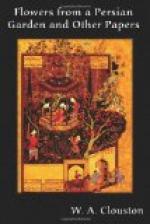It must be confessed that the frame of the Tuti Nama is of a very flimsy description: nothing could be more absurd, surely, than to represent the lady as decorating herself fifty-two nights in succession in order to have an interview with a young prince, and being detained each night by the Parrot’s tales, which, moreover, have none of them the least bearing upon the condition and purpose of the lady; unlike the Telugu story-book, having a somewhat similar frame (see ante, p. 127, note), in which the tales related by the bird are about chaste wives. But the frames of all Eastern story-books are more or less slight and of small account. The value of the Tuti Nama consists in the aid which the subordinate tales furnish in tracing the genealogy of popular fictions, and in this respect the importance of the work can hardly be over-rated.
ADDITIONAL NOTE.
THE MAGIC BOWL, pp. 152-156; 157, 158.
In our tale of the Faggot-maker, the fairies warn him to guard the Magic Bowl with the utmost care, “for it will break by the most trifling blow,” and he is to use it only when absolutely necessary; and in the notes of variants appended, reference is made (p. 158) to a Meklenburg story where the beer in an inexhaustible can disappears the moment its possessor reveals the secret. The gifts made by fairies and other superhuman beings have indeed generally some condition attached (most commonly, perhaps, that they are not to be examined until the recipients have reached home), as is shown pretty conclusively by my friend Mr. E. Sidney Hartland in a most interesting paper on “Fairy Births and Human Midwives,” which enriches the pages of the Archaeological Review for December, 1889, and at the close of which he cites, from Poestion’s Lapplaendische Maerchen, p. 119, a curious example, which may be fairly regarded as an analogue of the tale of the Poor Faggot-maker—“far cry” though it be from India to Swedish Lappmark:
“A peasant who had one day been unlucky at the chase was returning disgusted, when he met a fine gentleman, who begged him to come and cure his wife. The peasant protested in vain that he was no doctor. The other would take no denial, insisting that it was no matter, for if he would only put his hands on the lady she would be healed. Accordingly, the stranger led him to the very top of a mountain where was perched a castle he had never seen before. On entering, he found the walls were mirrors, the roof overhead of silver, the carpets of gold-embroidered silk, and the furniture of the purest gold and jewels. The stranger took him into a room where lay the loveliest of princesses on a golden bed, screaming with pain. As soon as she saw the peasant, she begged him to come and put his hands upon her. Almost stupified with astonishment, he hesitated to lay his coarse hands upon so fair a dame. But at length he yielded, and in a moment her pain ceased, and she was made whole. She stood up and thanked him, begging him to tarry awhile and eat with them. This, however, he declined to do, for he feared that if he tasted the food which was offered him he must remain there.




